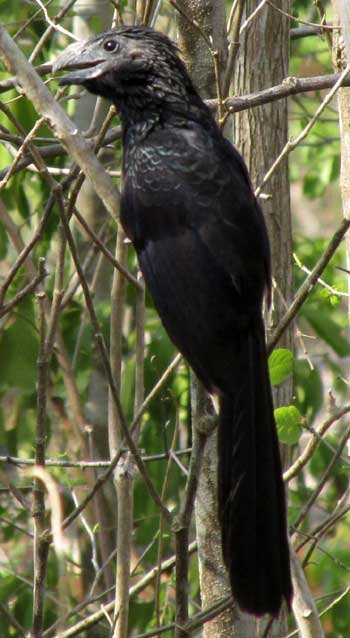Excerpts from Jim Conrad's
Naturalist Newsletter
from the March 17, 2007 Newsletter issued from Sierra Gorda Biosphere Reserve, QUERÉTARO, MÉXICO
GROOVE-BILLED ANI
Last week when I took our four visitors from Washington State along the reservoir they got very excited about seeing a bird I've thought of as a "weed bird" for so long that when I spotted it I didn't even think of pointing it out to them. It was a Groove-billed Ani, Crotophaga sulcirostris, shown below:
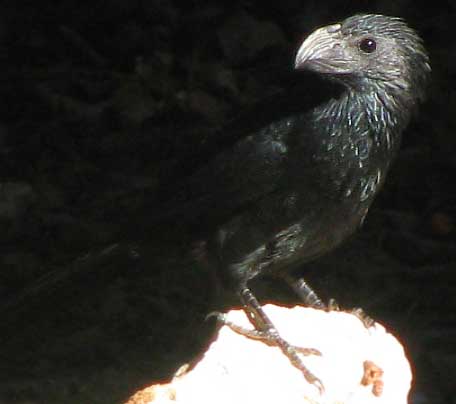
Anis are largish, all-black birds with long, round- pointed tails. "They look like grackles with somebody else's head," one of the visitors said, and that's right. In this area one becomes so accustomed to seeing and hearing raucous Great-tailed Grackles, which are the same size and all-black like anis, that the more subdued anis can be overlooked -- even though they're common, too.
As you can see in the above picture that the attention-getting thing about a Groove-billed Ani is its short but very thick, curved-topped bill which is longitudinally furrowed with "grooves." The grooves are easy to see if the light is just right -- which it isn't in the photo. I have no idea how these grooves benefit the bird. The un-grooved Smooth-billed Ani of southern Florida and the Caribbean gets along perfectly well without them.
Despite their similar black color and size, anis aren't closely related to grackles. In fact, anis are members of a completely different bird order, the Cuckoo Order, which besides anis also holds cuckoos and roadrunners. Two features uniting anis with cuckoos and roadrunners are these:
from the February 21, 2010 Newsletter issued from Hacienda Chichen Resort beside Chichén Itzá Ruins, central Yucatán, MÉXICO
ARMY ANTS & ANIS
For the last month most days if you looked around you could find seven or so Groove-billed Anis clustered on the ground or lolling in low perches. You can see four of them displaying their curious air of watchfulness below:
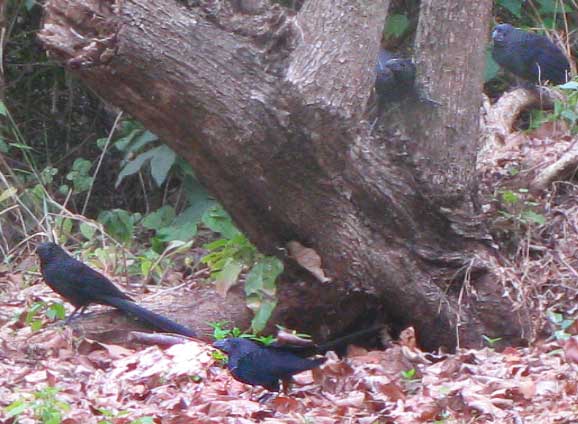
At first I figured that they were just being social but after seeing them at different places again and again, usually doing nothing but sometimes making quick pecks into the leaves, and sometimes rushing short distances in a curiously dainty-fast manner, like someone hurrying over crushed glass, it occurred to me that something special might be going on.
Ants were going on. Each day the anis were locating a battalion of foraging army ants. When the ants scared up a grasshopper, a small lizard or other such prey, the anis would try to get the goodies before the ants tore them apart. The trick for the anis was to avoid getting into the ants, for army ants bite anis, too.
Usually I see anis on ranchland where cattle stir up the anis' prey. Clearly to the anis it doesn't matter whether cattle or ants make grasshoppers abandon their shelter; just so they do.
from the July 4, 2010 Newsletter issued from Hacienda Chichen Resort beside Chichén Itzá Ruins, central Yucatán, MÉXICO
A FLEDGLING GROOVE-BILLED ANI
Along the trail a black bird sat on the ground looking around, only fluttering a little as I approached. It was a fledgling Groove-billed Ani apparently fresh from the nest. You can see his interesting head below:
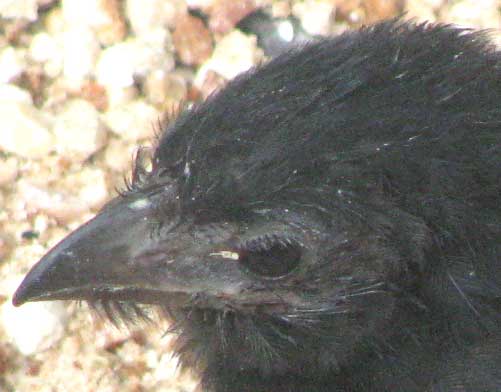
The head is interesting because it shows that the bills of fledgling Groove-billed Anis aren't grooved. The grooves must develop only with age.
from the July 25, 2010 Newsletter issued from Hacienda Chichen Resort beside Chichén Itzá Ruins, central Yucatán, MÉXICO
SUNBATHING ANI
It's been a rainy week, papers in my hut growing limp and soggy and my clothing smelling ever more of mildew. On Thursday afternoon the sun came out briefly and I wasn't the only one appreciating the chance to dry out.
Earlier we've seen how cormorants, Anhingas and Black Vultures spread their wings against the sun to dry out but I'd never seen any of the smaller birds do it until Thursday. You can see a soggy-looking Groove-billed Ani taking the sun right next to my hut below:
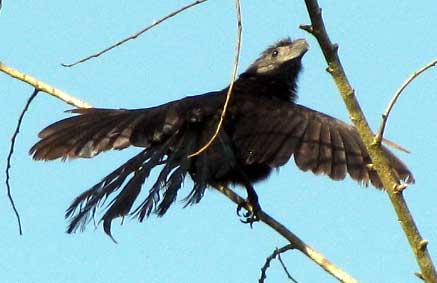
Anis are much smaller than cormorants, Anhingas and vultures -- about half the length of a Double-crested Cormorant. Still they're larger than most songbirds, being 14 inches in length (36 cm), compared to an American Robin's 8.5 inches (22 cm). So, spread-winged sunbathing still seems to be an activity of mainly larger, black birds, but now we know that even 14-inchers qualify.
from the May 14, 2017 Newsletter issued from Rancho Regenesis in the woods ±4kms west of Ek Balam Ruins; elevation ~40m (~130 ft), N20.876°, W88.170°; north-central Yucatán, MÉXICO
A HOT GROOVE-BILLED ANI
Sometimes anis perche near the hut. Here at the end of the dry season, afternoons are very hot, normally around 100°F or higher, and birds visiting at that time of day normally are just resting, looking around, not doing much of anything other than trying to keep cool. Usually they rest with their beaks open because they don't have sweat glands -- they cool off by increasing evaporation of moisture from their lungs, by panting like a dog. Below, you can see such an open-beaked ani:
